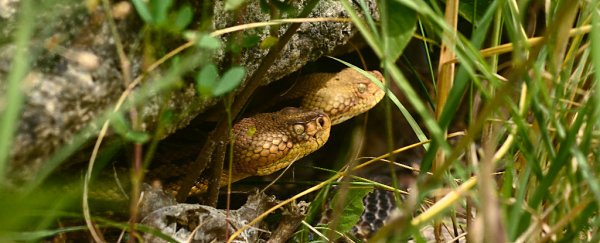Snakes, especially venomous ones, get a bad rap. But like every other creature, they're a vital part of the ecosystem, which is why researchers in Massachusetts plan on saving their Timber rattlesnake population by establishing a colony for them on Mount Zion - a closed-off island in central Massachusetts.
According to MassWildlife, a government organisation that monitors and protects the state's wildlife, Timber rattlesnakes (Crotalus horridus) have declined significantly over the last 30 years, and humans are mostly to blame. Snakes are often killed on sight by humans out of fear, despite the fact that doing so is illegal, and they generally leave people alone unless provoked. On top of this, snakes love to bask on roadways, where they're often slain by cars.
Most of the state's rattlesnakes now live in parks, but these are becoming more and more trafficked by the public. With little or no habitat left, the problem is now so bad that the species has been eliminated completely from other states, such as Maine and Rhode Island.
Before Massachusetts' rattlesnakes meet the same fate, researchers have proposed the establishment of a rattlesnake colony on Mount Zion Island in the Quabbin Reservoir, where they will no longer face a constant human threat. In fact, the public can't even access the island.
"The location proposed for this project is Mount Zion, the largest island in Quabbin Reservoir and off-limits to the public," the team announced. "At approximately 1,350 acres in size and 3.64 miles (5.8 km) in length, this island is comparable to the habitat areas currently occupied by Timber Rattlesnake populations in other parts of the state, providing enough space to support a small but healthy population."
To pull off the colony, the team will 'head start' the snakes at the Roger Williams Zoo on Rhode Island. This means that young snakes will live for about two years in captivity before making their way to the island. The plan is that by allowing the snakes to grow in captivity, it will make them more equipped to handle the outdoor environment and various predators than when they're younger.
The researchers also believe that the snakes will stay put on the island because they rarely, if ever, travel more than 2 miles (3.2 km) from their den. But what about swimming away?
"While rattlesnakes are perfectly good swimmers, their survival depends on access to unusually deep hibernation sites (hibernacula), usually in a rock talus or boulder field below a ledge, or a deep fissure in bedrock," the researchers explain. "These special habitats are scarce on our landscape. Any snake that leaves the island, whether by water or over the causeway, will not be able to find a suitable hibernation site and if unable to return will die over the winter."
All in all, the rattlesnake colony seems like the perfect solution to an ever-growing problem. Not only will the snake population be given the best chance to rebound, it will do so away from the humans who fear them. As of now, the project is still in its early development stage, and a start date hasn't been formally announced.
